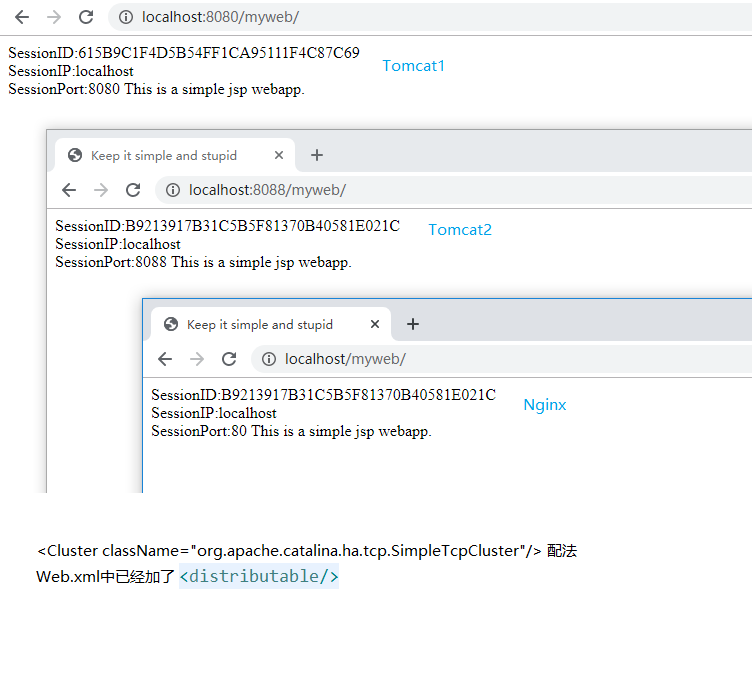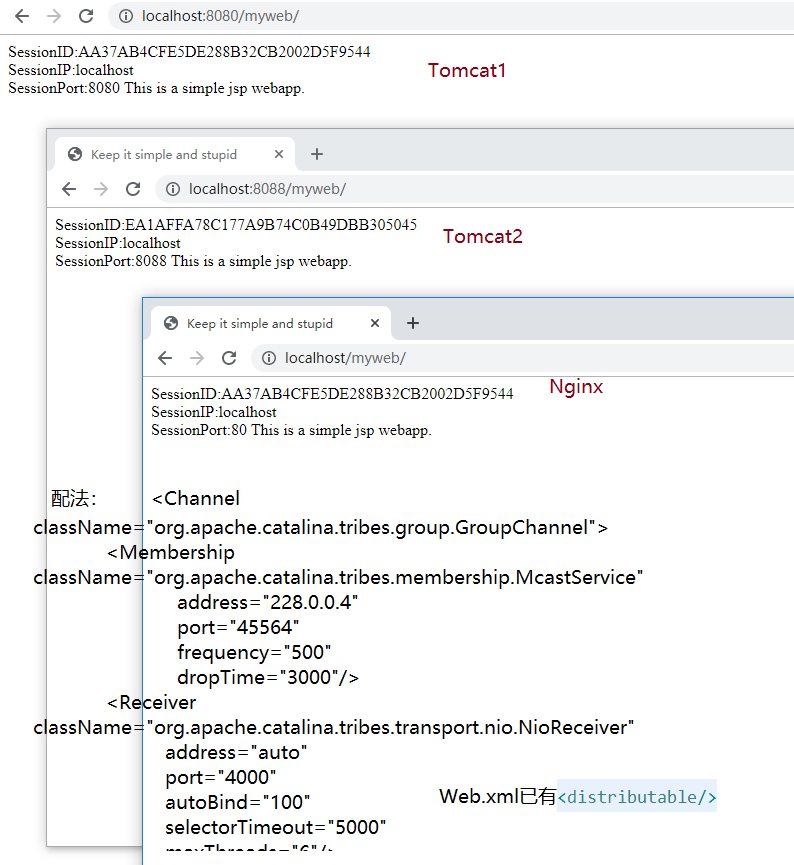[Failed]Tomcat cluster方案共享session配置出错,sigh....
后继发展:https://www.cnblogs.com/xiandedanteng/p/12134300.html
参考网文一:多个Tomcat之间实现Session共享
参考网文二:Tomcat官方文档
照这俩配了,结果令人沮丧,都没出来:
下面这种方案是在tomcat/conf/server.xml加<Cluster className="org.apache.catalina.ha.tcp.SimpleTcpCluster"/>去做的,结果两边session id不一致。

下面这种方案本是按网文一的做的,但tomcat都运行不起来,只好按网文2也就是Tomcat官方文档加入
<Engine name="Catalina" defaultHost="localhost">
<Cluster className="org.apache.catalina.ha.tcp.SimpleTcpCluster"
channelSendOptions="8"> <Manager className="org.apache.catalina.ha.session.DeltaManager"
expireSessionsOnShutdown="false"
notifyListenersOnReplication="true"/> <Channel className="org.apache.catalina.tribes.group.GroupChannel">
<Membership className="org.apache.catalina.tribes.membership.McastService"
address="228.0.0.4"
port="45564"
frequency="500"
dropTime="3000"/>
<Receiver className="org.apache.catalina.tribes.transport.nio.NioReceiver"
address="auto"
port="4000"
autoBind="100"
selectorTimeout="5000"
maxThreads="6"/> <Sender className="org.apache.catalina.tribes.transport.ReplicationTransmitter">
<Transport className="org.apache.catalina.tribes.transport.nio.PooledParallelSender"/>
</Sender>
<Interceptor className="org.apache.catalina.tribes.group.interceptors.TcpFailureDetector"/>
<Interceptor className="org.apache.catalina.tribes.group.interceptors.MessageDispatchInterceptor"/>
</Channel> <Valve className="org.apache.catalina.ha.tcp.ReplicationValve"
filter=""/>
<Valve className="org.apache.catalina.ha.session.JvmRouteBinderValve"/> <Deployer className="org.apache.catalina.ha.deploy.FarmWarDeployer"
tempDir="/tmp/war-temp/"
deployDir="/tmp/war-deploy/"
watchDir="/tmp/war-listen/"
watchEnabled="false"/> <ClusterListener className="org.apache.catalina.ha.session.ClusterSessionListener"/>
</Cluster>
结果还是session id不一致。

cmd窗口里出现下面错误:
27-Dec-2019 16:19:51.909 荳・驥・[Catalina-utility-2] org.apache.catalina.tribes.group.interceptors.TcpFailureDetector.memberAlive 譌豕戊ソ幄。悟、ア雍・逶第オ具シ悟∞螳壽・蜻伜ョ墓惻縲・org.apache.catalina.tribes.membership.MemberImpl[tcp://{10, 80, 87, 128}:4002,{10, 80, 87, 128},4002, alive=1675289, securePort=-1, UDP Port=-1, id={50 -112 68 12 11 -40 69 69 -72 -117 -78 30 69 90 -99 97 }, payload={}, command={}, domain={}]]
java.net.SocketException: Permission denied: connect
at java.net.DualStackPlainSocketImpl.waitForConnect(Native Method)
at java.net.DualStackPlainSocketImpl.socketConnect(DualStackPlainSocketImpl.java:85)
at java.net.AbstractPlainSocketImpl.doConnect(AbstractPlainSocketImpl.java:350)
at java.net.AbstractPlainSocketImpl.connectToAddress(AbstractPlainSocketImpl.java:206)
at java.net.AbstractPlainSocketImpl.connect(AbstractPlainSocketImpl.java:188)
at java.net.PlainSocketImpl.connect(PlainSocketImpl.java:172)
at java.net.SocksSocketImpl.connect(SocksSocketImpl.java:392)
at java.net.Socket.connect(Socket.java:589)
at org.apache.catalina.tribes.group.interceptors.TcpFailureDetector.memberAlive(TcpFailureDetector.java:340)
at org.apache.catalina.tribes.group.interceptors.TcpFailureDetector.memberAlive(TcpFailureDetector.java:326)
at org.apache.catalina.tribes.group.interceptors.TcpFailureDetector.performBasicCheck(TcpFailureDetector.java:269)
at org.apache.catalina.tribes.group.interceptors.TcpFailureDetector.checkMembers(TcpFailureDetector.java:230)
at org.apache.catalina.tribes.group.interceptors.TcpFailureDetector.heartbeat(TcpFailureDetector.java:222)
at org.apache.catalina.tribes.group.ChannelInterceptorBase.heartbeat(ChannelInterceptorBase.java:108)
at org.apache.catalina.tribes.group.GroupChannel.heartbeat(GroupChannel.java:201)
at org.apache.catalina.tribes.group.GroupChannel$HeartbeatRunnable.run(GroupChannel.java:831)
at java.util.concurrent.Executors$RunnableAdapter.call(Executors.java:511)
at java.util.concurrent.FutureTask.runAndReset(FutureTask.java:308)
at java.util.concurrent.ScheduledThreadPoolExecutor$ScheduledFutureTask.access$301(ScheduledThreadPoolExecutor.java:180)
at java.util.concurrent.ScheduledThreadPoolExecutor$ScheduledFutureTask.run(ScheduledThreadPoolExecutor.java:294)
at java.util.concurrent.ThreadPoolExecutor.runWorker(ThreadPoolExecutor.java:1142)
at java.util.concurrent.ThreadPoolExecutor$Worker.run(ThreadPoolExecutor.java:617)
at org.apache.tomcat.util.threads.TaskThread$WrappingRunnable.run(TaskThread.java:61)
at java.lang.Thread.run(Thread.java:745)
我猜是多播出现了问题,也许是单位网络限制所致,明后天准备在本机上再试一下。
搞得身心疲惫...最后附上三个配置,有高手路过请指点。
Tomcat1/conf/serverl.xml:
<?xml version="1.0" encoding="UTF-8"?>
<!--
Licensed to the Apache Software Foundation (ASF) under one or more
contributor license agreements. See the NOTICE file distributed with
this work for additional information regarding copyright ownership.
The ASF licenses this file to You under the Apache License, Version 2.0
(the "License"); you may not use this file except in compliance with
the License. You may obtain a copy of the License at http://www.apache.org/licenses/LICENSE-2.0 Unless required by applicable law or agreed to in writing, software
distributed under the License is distributed on an "AS IS" BASIS,
WITHOUT WARRANTIES OR CONDITIONS OF ANY KIND, either express or implied.
See the License for the specific language governing permissions and
limitations under the License.
-->
<!-- Note: A "Server" is not itself a "Container", so you may not
define subcomponents such as "Valves" at this level.
Documentation at /docs/config/server.html
-->
<Server port="8005" shutdown="SHUTDOWN">
<Listener className="org.apache.catalina.startup.VersionLoggerListener" />
<!-- Security listener. Documentation at /docs/config/listeners.html
<Listener className="org.apache.catalina.security.SecurityListener" />
-->
<!--APR library loader. Documentation at /docs/apr.html -->
<Listener className="org.apache.catalina.core.AprLifecycleListener" SSLEngine="on" />
<!-- Prevent memory leaks due to use of particular java/javax APIs-->
<Listener className="org.apache.catalina.core.JreMemoryLeakPreventionListener" />
<Listener className="org.apache.catalina.mbeans.GlobalResourcesLifecycleListener" />
<Listener className="org.apache.catalina.core.ThreadLocalLeakPreventionListener" /> <!-- Global JNDI resources
Documentation at /docs/jndi-resources-howto.html
-->
<GlobalNamingResources>
<!-- Editable user database that can also be used by
UserDatabaseRealm to authenticate users
-->
<Resource name="UserDatabase" auth="Container"
type="org.apache.catalina.UserDatabase"
description="User database that can be updated and saved"
factory="org.apache.catalina.users.MemoryUserDatabaseFactory"
pathname="conf/tomcat-users.xml" />
</GlobalNamingResources> <!-- A "Service" is a collection of one or more "Connectors" that share
a single "Container" Note: A "Service" is not itself a "Container",
so you may not define subcomponents such as "Valves" at this level.
Documentation at /docs/config/service.html
-->
<Service name="Catalina"> <!--The connectors can use a shared executor, you can define one or more named thread pools-->
<!--
<Executor name="tomcatThreadPool" namePrefix="catalina-exec-"
maxThreads="150" minSpareThreads="4"/>
--> <!-- A "Connector" represents an endpoint by which requests are received
and responses are returned. Documentation at :
Java HTTP Connector: /docs/config/http.html
Java AJP Connector: /docs/config/ajp.html
APR (HTTP/AJP) Connector: /docs/apr.html
Define a non-SSL/TLS HTTP/1.1 Connector on port 8080
-->
<Connector port="8080" protocol="HTTP/1.1"
connectionTimeout="20000"
redirectPort="8443" />
<!-- A "Connector" using the shared thread pool-->
<!--
<Connector executor="tomcatThreadPool"
port="8080" protocol="HTTP/1.1"
connectionTimeout="20000"
redirectPort="8443" />
-->
<!-- Define an SSL/TLS HTTP/1.1 Connector on port 8443
This connector uses the NIO implementation. The default
SSLImplementation will depend on the presence of the APR/native
library and the useOpenSSL attribute of the
AprLifecycleListener.
Either JSSE or OpenSSL style configuration may be used regardless of
the SSLImplementation selected. JSSE style configuration is used below.
-->
<!--
<Connector port="8443" protocol="org.apache.coyote.http11.Http11NioProtocol"
maxThreads="150" SSLEnabled="true">
<SSLHostConfig>
<Certificate certificateKeystoreFile="conf/localhost-rsa.jks"
type="RSA" />
</SSLHostConfig>
</Connector>
-->
<!-- Define an SSL/TLS HTTP/1.1 Connector on port 8443 with HTTP/2
This connector uses the APR/native implementation which always uses
OpenSSL for TLS.
Either JSSE or OpenSSL style configuration may be used. OpenSSL style
configuration is used below.
-->
<!--
<Connector port="8443" protocol="org.apache.coyote.http11.Http11AprProtocol"
maxThreads="150" SSLEnabled="true" >
<UpgradeProtocol className="org.apache.coyote.http2.Http2Protocol" />
<SSLHostConfig>
<Certificate certificateKeyFile="conf/localhost-rsa-key.pem"
certificateFile="conf/localhost-rsa-cert.pem"
certificateChainFile="conf/localhost-rsa-chain.pem"
type="RSA" />
</SSLHostConfig>
</Connector>
--> <!-- Define an AJP 1.3 Connector on port 8009 -->
<Connector port="8009" protocol="AJP/1.3" redirectPort="8443" /> <!-- An Engine represents the entry point (within Catalina) that processes
every request. The Engine implementation for Tomcat stand alone
analyzes the HTTP headers included with the request, and passes them
on to the appropriate Host (virtual host).
Documentation at /docs/config/engine.html --> <!-- You should set jvmRoute to support load-balancing via AJP ie :
<Engine name="Catalina" defaultHost="localhost" jvmRoute="jvm1">
-->
<Engine name="Catalina" defaultHost="localhost">
<Cluster className="org.apache.catalina.ha.tcp.SimpleTcpCluster"
channelSendOptions="8"> <Manager className="org.apache.catalina.ha.session.DeltaManager"
expireSessionsOnShutdown="false"
notifyListenersOnReplication="true"/> <Channel className="org.apache.catalina.tribes.group.GroupChannel">
<Membership className="org.apache.catalina.tribes.membership.McastService"
address="228.0.0.4"
port="45564"
frequency="500"
dropTime="3000"/>
<Receiver className="org.apache.catalina.tribes.transport.nio.NioReceiver"
address="auto"
port="4080"
autoBind="100"
selectorTimeout="5000"
maxThreads="6"/> <Sender className="org.apache.catalina.tribes.transport.ReplicationTransmitter">
<Transport className="org.apache.catalina.tribes.transport.nio.PooledParallelSender"/>
</Sender>
<Interceptor className="org.apache.catalina.tribes.group.interceptors.TcpFailureDetector"/>
<Interceptor className="org.apache.catalina.tribes.group.interceptors.MessageDispatchInterceptor"/>
</Channel> <Valve className="org.apache.catalina.ha.tcp.ReplicationValve"
filter=""/>
<Valve className="org.apache.catalina.ha.session.JvmRouteBinderValve"/> <Deployer className="org.apache.catalina.ha.deploy.FarmWarDeployer"
tempDir="/tmp/war-temp/"
deployDir="/tmp/war-deploy/"
watchDir="/tmp/war-listen/"
watchEnabled="false"/> <ClusterListener className="org.apache.catalina.ha.session.ClusterSessionListener"/>
</Cluster> <!-- Use the LockOutRealm to prevent attempts to guess user passwords
via a brute-force attack -->
<Realm className="org.apache.catalina.realm.LockOutRealm">
<!-- This Realm uses the UserDatabase configured in the global JNDI
resources under the key "UserDatabase". Any edits
that are performed against this UserDatabase are immediately
available for use by the Realm. -->
<Realm className="org.apache.catalina.realm.UserDatabaseRealm"
resourceName="UserDatabase"/>
</Realm> <Host name="localhost" appBase="webapps"
unpackWARs="true" autoDeploy="true">
<!-- <Context docBase="webapps/myweb" path="" reloadable="true" source="org.eclipse.jst.jee.server:myweb"/> -->
<!-- SingleSignOn valve, share authentication between web applications
Documentation at: /docs/config/valve.html -->
<!--
<Valve className="org.apache.catalina.authenticator.SingleSignOn" />
--> <!-- Access log processes all example.
Documentation at: /docs/config/valve.html
Note: The pattern used is equivalent to using pattern="common" -->
<Valve className="org.apache.catalina.valves.AccessLogValve" directory="logs"
prefix="localhost_access_log" suffix=".txt"
pattern="%h %l %u %t "%r" %s %b" /> </Host>
</Engine>
</Service>
</Server>
tomcat2/conf/serverl.xml
<?xml version="1.0" encoding="UTF-8"?>
<!--
Licensed to the Apache Software Foundation (ASF) under one or more
contributor license agreements. See the NOTICE file distributed with
this work for additional information regarding copyright ownership.
The ASF licenses this file to You under the Apache License, Version 2.0
(the "License"); you may not use this file except in compliance with
the License. You may obtain a copy of the License at http://www.apache.org/licenses/LICENSE-2.0 Unless required by applicable law or agreed to in writing, software
distributed under the License is distributed on an "AS IS" BASIS,
WITHOUT WARRANTIES OR CONDITIONS OF ANY KIND, either express or implied.
See the License for the specific language governing permissions and
limitations under the License.
-->
<!-- Note: A "Server" is not itself a "Container", so you may not
define subcomponents such as "Valves" at this level.
Documentation at /docs/config/server.html
-->
<Server port="8006" shutdown="SHUTDOWN">
<Listener className="org.apache.catalina.startup.VersionLoggerListener" />
<!-- Security listener. Documentation at /docs/config/listeners.html
<Listener className="org.apache.catalina.security.SecurityListener" />
-->
<!--APR library loader. Documentation at /docs/apr.html -->
<Listener className="org.apache.catalina.core.AprLifecycleListener" SSLEngine="on" />
<!-- Prevent memory leaks due to use of particular java/javax APIs-->
<Listener className="org.apache.catalina.core.JreMemoryLeakPreventionListener" />
<Listener className="org.apache.catalina.mbeans.GlobalResourcesLifecycleListener" />
<Listener className="org.apache.catalina.core.ThreadLocalLeakPreventionListener" /> <!-- Global JNDI resources
Documentation at /docs/jndi-resources-howto.html
-->
<GlobalNamingResources>
<!-- Editable user database that can also be used by
UserDatabaseRealm to authenticate users
-->
<Resource name="UserDatabase" auth="Container"
type="org.apache.catalina.UserDatabase"
description="User database that can be updated and saved"
factory="org.apache.catalina.users.MemoryUserDatabaseFactory"
pathname="conf/tomcat-users.xml" />
</GlobalNamingResources> <!-- A "Service" is a collection of one or more "Connectors" that share
a single "Container" Note: A "Service" is not itself a "Container",
so you may not define subcomponents such as "Valves" at this level.
Documentation at /docs/config/service.html
-->
<Service name="Catalina"> <!--The connectors can use a shared executor, you can define one or more named thread pools-->
<!--
<Executor name="tomcatThreadPool" namePrefix="catalina-exec-"
maxThreads="150" minSpareThreads="4"/>
--> <!-- A "Connector" represents an endpoint by which requests are received
and responses are returned. Documentation at :
Java HTTP Connector: /docs/config/http.html
Java AJP Connector: /docs/config/ajp.html
APR (HTTP/AJP) Connector: /docs/apr.html
Define a non-SSL/TLS HTTP/1.1 Connector on port 8080
-->
<Connector port="8088" protocol="HTTP/1.1"
connectionTimeout="20000"
redirectPort="8443" />
<!-- A "Connector" using the shared thread pool-->
<!--
<Connector executor="tomcatThreadPool"
port="8080" protocol="HTTP/1.1"
connectionTimeout="20000"
redirectPort="8443" />
-->
<!-- Define an SSL/TLS HTTP/1.1 Connector on port 8443
This connector uses the NIO implementation. The default
SSLImplementation will depend on the presence of the APR/native
library and the useOpenSSL attribute of the
AprLifecycleListener.
Either JSSE or OpenSSL style configuration may be used regardless of
the SSLImplementation selected. JSSE style configuration is used below.
-->
<!--
<Connector port="8443" protocol="org.apache.coyote.http11.Http11NioProtocol"
maxThreads="150" SSLEnabled="true">
<SSLHostConfig>
<Certificate certificateKeystoreFile="conf/localhost-rsa.jks"
type="RSA" />
</SSLHostConfig>
</Connector>
-->
<!-- Define an SSL/TLS HTTP/1.1 Connector on port 8443 with HTTP/2
This connector uses the APR/native implementation which always uses
OpenSSL for TLS.
Either JSSE or OpenSSL style configuration may be used. OpenSSL style
configuration is used below.
-->
<!--
<Connector port="8443" protocol="org.apache.coyote.http11.Http11AprProtocol"
maxThreads="150" SSLEnabled="true" >
<UpgradeProtocol className="org.apache.coyote.http2.Http2Protocol" />
<SSLHostConfig>
<Certificate certificateKeyFile="conf/localhost-rsa-key.pem"
certificateFile="conf/localhost-rsa-cert.pem"
certificateChainFile="conf/localhost-rsa-chain.pem"
type="RSA" />
</SSLHostConfig>
</Connector>
--> <!-- Define an AJP 1.3 Connector on port 8009 -->
<Connector port="8010" protocol="AJP/1.3" redirectPort="8443" /> <!-- An Engine represents the entry point (within Catalina) that processes
every request. The Engine implementation for Tomcat stand alone
analyzes the HTTP headers included with the request, and passes them
on to the appropriate Host (virtual host).
Documentation at /docs/config/engine.html --> <!-- You should set jvmRoute to support load-balancing via AJP ie :
<Engine name="Catalina" defaultHost="localhost" jvmRoute="jvm1">
-->
<Engine name="Catalina" defaultHost="localhost">
<Cluster className="org.apache.catalina.ha.tcp.SimpleTcpCluster"
channelSendOptions="8"> <Manager className="org.apache.catalina.ha.session.DeltaManager"
expireSessionsOnShutdown="false"
notifyListenersOnReplication="true"/> <Channel className="org.apache.catalina.tribes.group.GroupChannel">
<Membership className="org.apache.catalina.tribes.membership.McastService"
address="228.0.0.4"
port="45564"
frequency="500"
dropTime="3000"/>
<Receiver className="org.apache.catalina.tribes.transport.nio.NioReceiver"
address="auto"
port="4088"
autoBind="100"
selectorTimeout="5000"
maxThreads="6"/> <Sender className="org.apache.catalina.tribes.transport.ReplicationTransmitter">
<Transport className="org.apache.catalina.tribes.transport.nio.PooledParallelSender"/>
</Sender>
<Interceptor className="org.apache.catalina.tribes.group.interceptors.TcpFailureDetector"/>
<Interceptor className="org.apache.catalina.tribes.group.interceptors.MessageDispatchInterceptor"/>
</Channel> <Valve className="org.apache.catalina.ha.tcp.ReplicationValve"
filter=""/>
<Valve className="org.apache.catalina.ha.session.JvmRouteBinderValve"/> <Deployer className="org.apache.catalina.ha.deploy.FarmWarDeployer"
tempDir="/tmp/war-temp/"
deployDir="/tmp/war-deploy/"
watchDir="/tmp/war-listen/"
watchEnabled="false"/> <ClusterListener className="org.apache.catalina.ha.session.ClusterSessionListener"/>
</Cluster>
<!--For clustering, please take a look at documentation at:
/docs/cluster-howto.html (simple how to)
/docs/config/cluster.html (reference documentation) --> <!-- <Cluster className="org.apache.catalina.ha.tcp.SimpleTcpCluster"/> --> <!-- Use the LockOutRealm to prevent attempts to guess user passwords
via a brute-force attack -->
<Realm className="org.apache.catalina.realm.LockOutRealm">
<!-- This Realm uses the UserDatabase configured in the global JNDI
resources under the key "UserDatabase". Any edits
that are performed against this UserDatabase are immediately
available for use by the Realm. -->
<Realm className="org.apache.catalina.realm.UserDatabaseRealm"
resourceName="UserDatabase"/>
</Realm> <Host name="localhost" appBase="webapps"
unpackWARs="true" autoDeploy="true">
<!-- <Context docBase="webapps/myweb" path="" reloadable="true" source="org.eclipse.jst.jee.server:myweb"/> --> <!-- SingleSignOn valve, share authentication between web applications
Documentation at: /docs/config/valve.html -->
<!--
<Valve className="org.apache.catalina.authenticator.SingleSignOn" />
--> <!-- Access log processes all example.
Documentation at: /docs/config/valve.html
Note: The pattern used is equivalent to using pattern="common" -->
<Valve className="org.apache.catalina.valves.AccessLogValve" directory="logs"
prefix="localhost_access_log" suffix=".txt"
pattern="%h %l %u %t "%r" %s %b" /> </Host>
</Engine>
</Service>
</Server>
Nginx/conf/nginx.conf:
#user nobody;
worker_processes 1; #error_log logs/error.log;
#error_log logs/error.log notice;
#error_log logs/error.log info; #pid logs/nginx.pid; events {
worker_connections 1024;
} http {
include mime.types;
default_type application/octet-stream; access_log logs/access.log; sendfile on; keepalive_timeout 65; upstream tomcat{
server localhost:8080;
server localhost:8088;
} server {
listen 80;
server_name localhost;
client_max_body_size 1024m; location / {
proxy_pass http://tomcat;
proxy_set_header Host $host:$server_port;
} error_page 500 502 503 504 /50x.html;
location = /50x.html {
root html;
}
} server {
listen 8001;
access_log logs/8001.log; location / {
root html/8001;
index index.html;
}
} server {
listen 8002;
access_log logs/8002.log; location / {
root html/8002;
index index.html;
}
} server {
listen 8003;
access_log logs/8003.log; location / {
root html/8003;
index index.html;
}
} autoindex on;# show folder
autoindex_exact_size on;# show file size
autoindex_localtime on;# show file modification time server {
listen 9999 default_server;
listen [::]:9999 default_server;
server_name _;
root D:\Users\os-yang.he\software; location / {
} error_page 404 /404.html;
location = /40x.html {
} error_page 500 502 503 504 /50x.html;
location = /50x.html {
}
} }
--End-- 2019-12-27 16:21
[Failed]Tomcat cluster方案共享session配置出错,sigh....的更多相关文章
- Tomcat cluster方案共享session配置成功,yeah....
后继版本:https://www.cnblogs.com/xiandedanteng/p/12143112.html 参考网文: 1.Tomcat官方文档 2.https://blog.51cto.c ...
- Tomcat三实例cluster多播方案共享session再配置
昨天已经将两实例cluster多播方案共享Session配置成功,其中的关键就在于server.xml中,engine->channel->receiver节点中address得写成自己的 ...
- tomcat-8.0.18 cluster 使用Redis共享Session 配置
事实证明 这位作者提在https://jingyan.baidu.com/article/ac6a9a5e10415f2b653eace8.html 最底下的http://pan.baidu.com/ ...
- spring-session使用配置(分布式共享session配置)
1. 添加依赖 <dependency> <groupId>org.springframework.session</groupId> <artifactId ...
- Tomcat集群的session共享
配置Tomcat的session共享可以有三种解决方案: 第一种是以负载均衡服务器本身提供的session共享策略,每种服务器的配置是不一样的并且nginx本身是没有的. 第二种是利用web容器本身的 ...
- linux下实现redis共享session的tomcat集群
为了实现主域名与子域名的下不同的产品间一次登录,到处访问的效果,因此采用rediss实现tomcat的集群效果.基于redis能够异步讲缓存内容固化到磁盘上,从而当服务器意外重启后,仍然能够让sess ...
- Tomcat通过Redis实现session共享的完整部署记录
对于生产环境有了一定规模的tomcat集群业务来说,要实现session会话共享,比较稳妥的方式就是使用数据库持久化session.为什么要持久化session(共享session)呢?因为在客户端每 ...
- Tomcat 集群 + Redis Session 共享出现 Session 瞬间失效问题
写在前面的话 写这篇博客出于公司最近要迁移到新的云上面且对之前的资源,架构做一个升级. 本来是一个不大的项目,旧环境旧一个 TOMCAT 跑起来,不过出于高可用考虑,新环境决定使用 TOMCAT 集群 ...
- 细说tomcat之集群session共享方案
1. Tomcat Cluster官网:http://tomcat.apache.org/tomcat-7.0-doc/cluster-howto.htmlTomcat原生支持的集群方案,通过组播消息 ...
随机推荐
- [深度学习] Pytorch(三)—— 多/单GPU、CPU,训练保存、加载模型参数问题
[深度学习] Pytorch(三)-- 多/单GPU.CPU,训练保存.加载预测模型问题 上一篇实践学习中,遇到了在多/单个GPU.GPU与CPU的不同环境下训练保存.加载使用使用模型的问题,如果保存 ...
- 2018-04-19:innodb和myisam区别
福哥答案2020-04-19:
- Quartz.Net的基础使用方法,单任务执行
1.先创建一个控制台应用程序 2.应用Quartz的NuGet包 3.编写执行任务代码 using System; using System.Threading.Tasks; using Quar ...
- Webpack开发指南
前言 成为一个全栈工程师,前端是必不可少的,这位前端构建工具webpack是一门必修的技术. 在学习webpack之前,先熟悉一下npm工具:https://www.runoob.com/nodejs ...
- 【期外】(三)Linux下集成开发环境Geany
今天小编发现了一个很好的软件,它的名字就叫做Geany. 这是Linux系统中的开发工具,相当的好用. Linux与windows最大的不同正是不是集成开发环境,所以写起代码来总是用文档写好后,然后再 ...
- ssh连接:Socket error Event: 32 Error: 10053.
今天在使用xshell连接刚装的linux系统的时候,发现无法建立连接,会报如下错误: Connecting to 192.168.21x.x:22...Connection established. ...
- java 工具类Integer
Integer 是lang包下的工具类 为了更加熟悉Integer中的方法使用和理解 进行了一部分代码和原代码的总结 Intrger工具类方法: * * int parseInt(String s) ...
- Linux内核之 内存管理
前面几篇介绍了进程的一些知识,从这篇开始介绍内存.文件.IO等知识,发现更不好写哈哈.但还是有必要记录下自己的所学所思.供后续翻阅,同时写作也是一个巩固的过程. 这些知识以前有文档涉及过,但是角度不同 ...
- 个人项目WC.exe Node.js+electron实现
前言 实现语言:Javascript 编译工具:webstorm GitHub:https://github.com/NPjuan/WC.git 项目要求 wc.exe 是一个常见的工具,它能统计文本 ...
- 解决SpringBoot jar包中的文件读取问题
前言 SpringBoot微服务已成为业界主流,从开发到部署都非常省时省力,但是最近小明开发时遇到一个问题:在代码中读取资源文件(比如word文档.导出模版等),本地开发时可以正常读取 ,但是,当我们 ...
